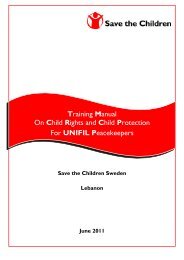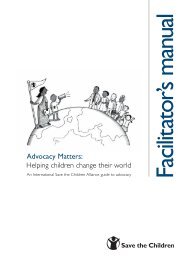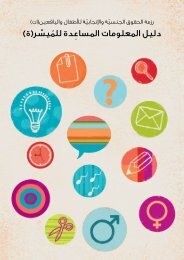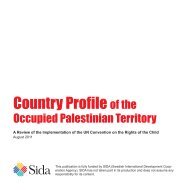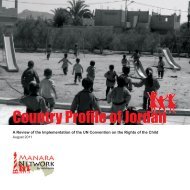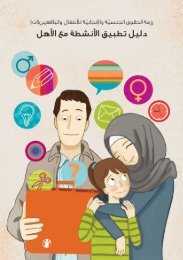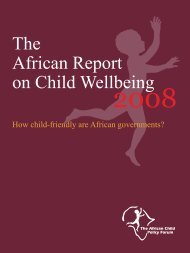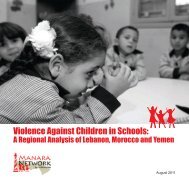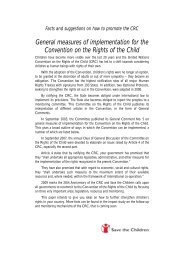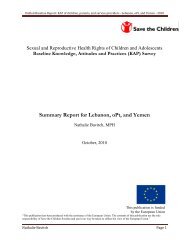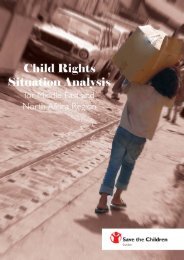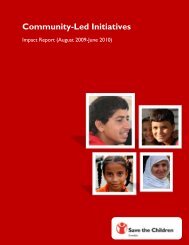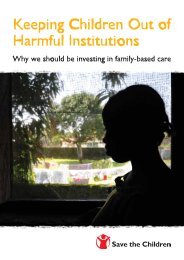Country Profile of Morocco - International Bureau of Children's Rights
Country Profile of Morocco - International Bureau of Children's Rights
Country Profile of Morocco - International Bureau of Children's Rights
You also want an ePaper? Increase the reach of your titles
YUMPU automatically turns print PDFs into web optimized ePapers that Google loves.
available on the number <strong>of</strong> children supported by the<br />
UPE since their launch.<br />
The Government also undertook legislative reforms in<br />
November 2003, raising the age <strong>of</strong> protection <strong>of</strong> children<br />
victims <strong>of</strong> violence from 12 to 15 years <strong>of</strong> age (Article<br />
408). Moreover, new infractions were integrated into the<br />
penal code through Law 24-03 <strong>of</strong> 2003 that made it illegal<br />
to force children to work (Article 467-2), to sexually exploit<br />
children (Article 497-499) and to make child pornography<br />
(Article 503-2). 193<br />
Finally, new support for children victims <strong>of</strong> violence in<br />
hospital <strong>of</strong>fers medical, psychological, and legal support<br />
to victims. The initial project was launched in 2006, establishing<br />
a manual on support for child victims, and has<br />
since been implemented in four other units (Marrakesh,<br />
Kalaa, Essaouira and Beni Mellal). Trainings were provided<br />
based on this manual to judges, policemen, doctors and<br />
other stakeholders working with children. 194<br />
The ACHR collaborated with UNICEF on a 2008 study<br />
on mechanisms for receiving, prosecuting and following<br />
up on violations <strong>of</strong> children’s rights. 195 The main goal <strong>of</strong><br />
this study was to present the international framework and<br />
propose initiatives that could be put in place in <strong>Morocco</strong><br />
and to shine the light on existing national mechanisms for<br />
promoting and protecting children’s rights. 196 The study’s<br />
findings showed that national mechanisms should be a<br />
part <strong>of</strong> already-existing structures, such as the NOCR. 197<br />
However, it also showed that these national mechanisms<br />
should be implemented in all regions <strong>of</strong> the country to<br />
guarantee that they are available for all children. 198<br />
The Advisory Council for Human <strong>Rights</strong> held on the 20 th<br />
Anniversary for the CRC and the 60 th anniversary <strong>of</strong> the<br />
Advisory Council a seminar in February 2009 on child<br />
protection. This seminar was held with the participation<br />
39<br />
<strong>of</strong> government institutions, members <strong>of</strong> the Advisory<br />
Council and NGOs to recall the importance <strong>of</strong> integrating<br />
human rights and child rights into public policies. 199<br />
Also supporting NGOs networking in the field <strong>of</strong> child<br />
protection, UNICEF published in 2006, in partnership<br />
with the National Mutual Aid, a guide to NGOs working<br />
in the field <strong>of</strong> children’s rights in the city <strong>of</strong> Marrakesh.<br />
This guide provides organisational contacts and an overview<br />
<strong>of</strong> the organisation’s activities in the field <strong>of</strong> child<br />
protection. 200<br />
f.<br />
Sexual Exploitation and Abuse<br />
According to End Child Prostitution, Child Pornography<br />
and Trafficking <strong>of</strong> Children for Sexual Purposes<br />
(ECPAT), the number <strong>of</strong> child victims <strong>of</strong> sexual exploitation<br />
in the major urban centres <strong>of</strong> <strong>Morocco</strong> is estimated<br />
at over 10,000. Young girls labouring as domestic workers<br />
are said to be the most vulnerable, with UNICEF estimating<br />
that nearly 13,500 girls under 15 are employed as<br />
domestic workers in Casablanca. 201<br />
Although <strong>of</strong>ficial data is lacking on the topic, among the<br />
thousands <strong>of</strong> calls received by the NODS helpline, 75%<br />
<strong>of</strong> calls involve sexual assault. 202 A 2003 study conducted<br />
by UNICEF on the sexual exploitation <strong>of</strong> children in<br />
Marrakesh showed that out <strong>of</strong> a sample <strong>of</strong> 100 minors,<br />
61% were aged between 16 and 18 years old; 32% between<br />
14 to 15 years old and 7% between 10 and 13<br />
years. 203 This same study found that a minor’s family<br />
background was another key factor: 61% <strong>of</strong> children<br />
victims <strong>of</strong> sexual exploitation reported being ill-treated at<br />
home. The study also showed that 62% came from a poor<br />
background. 204<br />
In order to harmonise national legislation with the CRC<br />
and other international conventions, the Government




